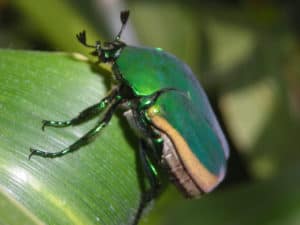Something is making a loud buzzing sound in your backyard? If you have ripe fruits in your garden, it is likely that their fermentation odor attracts the figeater beetle. These large, metallic green beetles, the common pests in the Southwestern U.S. and Mexico, breed on flower petals, plant’s and desert tree’s sap, cacti fruits and soft-skinned fruits like figs, grapes, guava, nectarines plums, peaches, berries and tomatoes. Though they are not extremely harmful for your trees, fruits or lawn, their presence can be annoying. If you don’t want these insects in your backyard or among your fruits, read on to learn how to control them.

What is a Figeater Beetle
Figeater beetle (Cotinis Mutabilis), also known as green fruit beetle or fig beetle, is a member of the scarab beetle family of the extremely large order Coleoptera (Beetles).
 It is very conspicuous and easily recognizable insect due to its beautiful coloration. Fig beetle is a semi-glossy dark green on the top with a cream-colored band around the edge of the elytra (hardened forewing of certain insects, mostly beetles). The undersides of its prominent legs are iridescent green. This beetle is quite large – the adult can grow up to 1.3 inches big.
It is very conspicuous and easily recognizable insect due to its beautiful coloration. Fig beetle is a semi-glossy dark green on the top with a cream-colored band around the edge of the elytra (hardened forewing of certain insects, mostly beetles). The undersides of its prominent legs are iridescent green. This beetle is quite large – the adult can grow up to 1.3 inches big.
Green Fig Beetles have a single generation per year, although they may remain in the soil for two years. Larvae or grubs, called Crawly backs, emerge from the eggs in fall and then live deep in the compost or mulch during winter. Their second larvae stage begins in spring. After a tremendous metamorphosis from the larva stage, they finally emerge as winged adults in summer.
In late summer, when fruits go ripe, soft, and juicy, fig beetles have plentiful of food. That is the time of year when they are mostly active, searching for the mate and feeding on fruits.
They actually seek for the fruits that have already been damaged by other insects and birds. Their mouthparts are very weak and ineffective in opening most other plant material, so they are able to chew only soft, thin-skinned fruits with previous damage. Larvae do not damage fruit.
Figeater beetle is active during daylight time, making a buzzing, bumblebee-like sound while flies. The sound actually comes from the partially closed elytra when in flight. This makes them slow and clumsy fliers that often collide with walls, trees, houses, large objects and sometimes even humans.
Figeater beetle is usually mistaken for their eastern relatives – green June beetle (Cotinis nitida) and Japanese beetle (Popillia japonica). But, unlike figeater beetle, they occur in eastern parts of the U.S. and have noticeably browner and bronzier green elytra. They appear to be severe pests that can cause a serious damage to trees and lawns. Fig beetle is less destructive.
How to control Figeater Beetle
The figeater beetle is hardly considered as a pest. Although it feeds on the ripe fruits, it causes little economic damage and will probably not significantly damage your fruit crop. But if the population is extremely large, you may want to consider some control method.
If you find them as an unwanted nuisance, think prevention measures first.
- Control during the larval stage
Controlling during this stage is the easiest and the most recommended prevention method. Since the larvae thrive on mulch, compost or manure piles, or leaf litter, try to cover or remove these organic layers that provide food and shelter for them. If you turn over compost piles more regularly or till your garden frequently in the spring, you will expose larvae, making them an easy take for birds and predators. But, keep in mind that fig beetle larvae are beneficial to garden soil – they break down organic matter along with other insects and worms.
- Remove the food source
You can also try to remove the food source for adult beetles. Try to pick and collect fruits in the moment of ripeness. This way you’ll keep fig beetles from eating your fruits. It may seem overwhelming, but it could be an easy, daily-routine work.
- Hand-picking beetles
Attempt to hand pick the beetles but only when the beetle population is still small. Hand picking is fairly easy and may be effective if started on time.
- Use a “sweet” home-made trap
Since the fig beetle is attracted to anything sweet, you can capture it using a homemade trap. Make a 1:1 mixture of water and fruit juice and place it in a 1-gallon container and insert a funnel of wire mesh in the container opening with its widest opening facing up. This sweet bait will attract fig beetles and once they’ve entered the funnel which leads to the container, they won’t be able to get out.
- Chemical control
This method is not recommended for this occasional pest. Insecticides are of little value against the fig beetle.
Figeater Beetle Symbolism
Although some people are scared of the fig beetle and beetles generally, these bugs are actually symbols of transformation and eternity. Scarabs and other beetles have been worshiped by many civilizations. The ancient Egyptians regarded the beetle, especially scarab, as a symbol of the Sun, birth and eternal return.
Native Americans believed that Universe talked to us through nature – trees, weather, animals etc. Beetles were the messengers of the Universe.
Fig beetle is a symbol of changes and transformation. If you encounter this insect, it is believed that Nature is talking to you through the beetle, asking you to consider the potential opportunities and make changes in your own life.
Are Figeater Beetles Dangerous?
Though it may seem the fig beetle has just attacked you, don’t worry – fig beetle has probably collided with you unintentionally. Their lack of proper navigation is related to the fact they open their elytra only partially while flying. They are extremely loud fliers and amusingly clumsy so every encounter with this beetle is unintentional. They don’t bite humans and are completely harmless.
Actually, they play an important role in recycling organic material. They are beneficial and helpful to urban ecosystems – they feed on ripe and rotten fruits. Larvae are assisting in the composting process. They are often found in compost pile or mulch, decomposing organic material and enriching the soil.